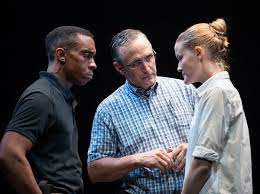
As New York’s stages continue to fill up, it is gratifying to see audiences back in full support of their favorites or taking in a new work. I was beyond thrilled that Complexions Contemporary Ballet returned for a two week stint at the Joyce to a packed house on opening night. Their artistry and their athleticism are on full display in this entertaining and thought provoking dance.
Program A contains two parts. Snatched Back From the Edges is a world premiere piece conceived and created during the height of the pandemic. The program notes the challenges of gun violence, racial inequality and social struggles. The dances contained here are “inspired by the pain, tenacity, and advocacy for change – that inner strength that continues to propel the world forward – through it all.”
The company’s dancers are multi-national representing Italy, Australia, Canada, Columbia, Japan and all corners of the United States. This diversity is further represented by color and size. There is not a cookie cutter approach to the formation of this unit and the variety makes for exciting combinations and interesting juxtapositions. They are all, however, supremely fit as the choreography is intense, angular and energetic.
Seven sections make up Snatched Back From the Edges. The pieces are accompanied by music and spoken word, including Terrell Lewis’ Fear. “Fear used to be my ball and chain” is followed by “I have now changed.” Everyone of us has changed over the past two years. The words and the lyrics underscore the aggressive and occasionally slinky dance movements. We are asked to think not simply revel in the beautiful lighting and gorgeous bodies.
“The Future” is a song from Aloe Blacc (born Egbert Nathaniel Dawkins III) which nicely sums up the introspective yet positive outlook of the piece. “There is a light at the end of this road / And I know there’s still a long way to go.” The chorus then intones “the future belongs to me” and “it’s gon’ be a beautiful thing to see.” Choreographer and co-founding Artistic Director Dwight Rhoden created a work that allows us to feel and think while taking in the visual splendor and movement.
The second half of this show is a reprise of 2020’s Love Rocks containing eight Lenny Kravitz songs. I saw the premier of this dance and it should be considered essential to this company’s repertoire. The dance is a glorious feast for the eyes and ears. If you love to watch transitions these are inventive, varied and fun. The prancing in “I Belong to You” and the gazelles in “Fly Away” are witty and command attention. This is dance as sport. How can you tell? When the dancers pause, even for a moment or two, their breathing makes it clear.
Each dancer brings his or her personal style to this type of choreography. The musicality of Vincenzo di Primo suggests every note runs through his body. Jillian Davis remains an arrestingly tall, graceful and angular presence. It is difficult to look away when she is on stage. Jarrett Reimers, in his second season, was a standout as well notably in his duets. While every dancer gets their time in the spotlight, Thomas Dilley, Brandon Gray, Terrence Matthews and Aidan Wolf were especially memorable.
Was this the tightest performance I’ve ever seen from Complexions? No. When everyone is spot on and nails the choreography perfectly, the imagery is unrelentingly cool. This is muscular, sexy, ultra-flexible and aerobically challenging dance. Complexions’ dancers work hard and the result is two hours of awe inspiring visual delights. This is dance for everyone to enjoy.
Complexions Contemporary Ballet will be performing two different programs at the Joyce Theater through November 28, 2021.










You must be logged in to post a comment.